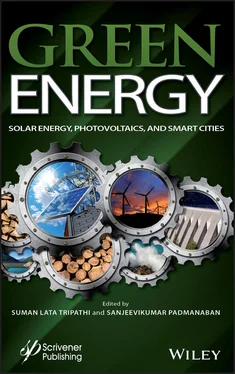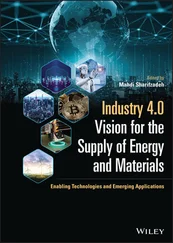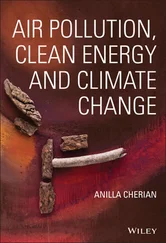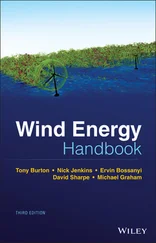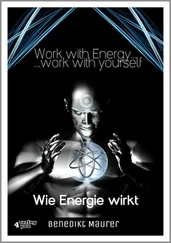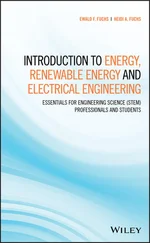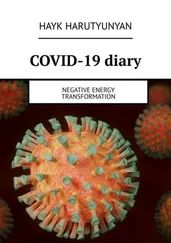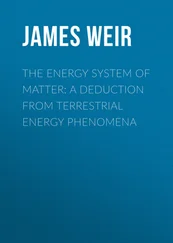9 Chapter 9Figure 9.1 Generic structure of a PV system.Figure 9.2 Equivalent circuit.Figure 9.3 Ideal solar cell.Figure 9.4 Flow diagram for panel modelling.Figure 9.5 IV characteristics of the panel.Figure 9.6 PV characteristics of the panel.Figure 9.7 Improvement in IV characteristics.Figure 9.8 Improvement in PV characteristics.Figure 9.9 IV curve for the combined model.Figure 9.10 PV curve for the combined model.Figure 9.11 PV characteristics for varying irradiation.Figure 9.12 IV characteristics for varying irradiation.Figure 9.13 PV characteristics for varying temperature.Figure 9.14 IV characteristics for varying temperature.
10 Chapter 10Figure 10.1 Operation of Solar Cell.Figure 10.2 Equivalent circuit of solar cell: (a) One-diode model (b) Two-diode ...Figure 10.3 Typical I-V characteristics of a solar PV module.Figure 10.4 Typical P-V curve of a solar PV module.Figure 10.5 Solar Panel I-V and Power Curve.Figure 10.6 Different Irradiance Levels on a Solar Panel.Figure 10.7 Temperature Effect on Solar Panel Power and I-V Curves.Figure 10.8 Modeling of PV Panel.Figure 10.9 Output voltage, current and power of a PV panel.Figure 10.10 PV panel interfaced with boost converter.Figure 10.11 Topologies of power converters.Figure 10.12 Equivalent circuit of boost converter.Figure 10.13 Steady state voltage and current waveform of boost converter.Figure 10.14 Equivalent circuit of buck-boost converter.Figure 10.15 Steady-state voltage and current waveform of buck-boost converter.Figure 10.16 Classification of DC link inverters.Figure 10.17 Block diagram of BCMLI.Figure 10.18 Equivalent circuit of seven-level BCMLI.Figure 10.19 Mode 1 operations: (a) At t = TON1 (b) At t = TOFF1.Figure 10.20 Voltage across Sb1 and inductor current at mode 1 operation.Figure 10.21 Mode 2 operations: (a) At t = TON2 (b) At t = TOFF2.Figure 10.22 Voltage across Sb1 and Sb2 and inductor current at mode 2 operation...Figure 10.23 Mode 3 operations: (a) At t = TON3 (b) At t = TOFF3.Figure 10.24 Voltage across Sb1, Sb2 and Sb3 and inductor current at mode 3 oper...Figure 10.25 Typical output voltage waveform of seven-level BCMLI.Figure 10.26 General structure of BCDCLHBI.Figure 10.27 Equivalent structure of seven-level BCDCLHBI With Battery.Figure 10.28 Equivalent structure of seven-level BCDCLHBI with Solar PV.Figure 10.29 Operation of BCDCLHBI: (a) Mode 1 operation at t = TON1 (b) Mode 1 ...Figure 10.30 Inductor current waveform at t = TON1 and t = TOFF1.Figure 10.31 Operation of BCDCLHBI: (a) Mode 2 operation at t = TON1 (b) Mode 2 ...Figure 10.32 Inductor current waveform at t = TON2 and t = TOFF2.Figure 10.33 Operation of BCDCLHBI: (a) Mode 3 operation at t = TON3 (b) Mode 3 ...Figure 10.34 Inductor current waveform at t = TON3 and t = TOFF3.Figure 10.35 Typical voltage waveform of seven-level BCDCLHBI.Figure 10.36 Block diagram of single-phase seven-level BCDCLHBI.Figure 10.37 Hardware realization circuit of single phase seven-level BCDCLHBI.Figure 10.38 Gate Driver Circuit Specifications of single-phase BCDCLHBI systems...
11 Chapter 11Figure 11.1 Modified double-diode model.Figure 11.2 Schematic diagram of Harris hawks optimization phases [18].Figure 11.3 Kruskal Wallis test performance for KC200GT model.Figure 11.4 Kruskal Wallis test mean ranks for MSX-60 model.Figure 11.5 Kruskal Wallis test results for CS6K-280M model.Figure 11.6 Convergence Curve for a MDDM (Kyocera KC200GT).Figure 11.7 Convergence Curve for a MDDM (Solarex MSX-60).Figure 11.8 Convergence Curve for MDDM (Canadian Solar CS6K-280M).
12 Chapter 12Figure 12.1 Typical applications of suggested topology.Figure 12.2 Proposed step-up converter.Figure 12.3 Equivalent circuit of suggested topology in a) Mode I, b) Mode II, c...Figure 12.4 The key waveforms of suggested structure.Figure 12.5 Voltage conversion ratio of proposed topology versus different duty ...Figure 12.6 The real model of proposed topology considering parasitic components...Figure 12.7 The real and typical real gain of proposed topology.Figure 12.8 Comparison between boosting capability of proposed and [33-36] topol...Figure 12.9 Comparison between proposed structure and [33-36] from viewpoint of:...Figure 12.10 Comparison between ANVS of proposed and [33-36] topologies.Figure 12.11 Output voltage and load current waveforms of proposed topology.Figure 12.12 Voltage and current waveforms of capacitors a) C1, b) Co.Figure 12.13 Voltage and current waveforms of inductors a) L1, b) L2.Figure 12.14 Input current waveform of proposed topology.Figure 12.15 Voltage and current waveforms of semiconductors of suggested struct...
13 Chapter 13Figure 13.1 Configuration of microgrid.Figure 13.2 AC microgrid.Figure 13.3 DC microgrid.Figure 13.4 Classification of microgrid stability.
14 Chapter 14Figure 14.1 Inverter-fed SPMSM system.Figure 14.2 Seven zones in one switching cycle in SVPWM.Figure 14.3 Ripple current variation in one switching cycle in SVPWM.Figure 14.4 Switch combination of eight different voltage vectors and their Thev...Figure 14.5 PMSM speed response (under constant switching frequency PWM [fsw = 2...Figure 14.6 Response of electromagnetic torque (load torque = 25.8 N.m) (under c...Figure 14.7 Three-phase stator currents (under constant switching frequency PWM ...Figure 14.8 VSFPWM control diagram.Figure 14.9 Switching period calculation module.Figure 14.10 Response of electromagnetic torque (Switch over process between con...Figure 14.11 Three-phase stator currents (Switch over process).Figure 14.12 Switching frequency variation.
15 Chapter 15Figure 15.1 Home automation.Figure 15.2 IoT Protocols.
16 Chapter 16Figure 16.1 Active Energy Consumption in Covenant University from 2014 to 2018.Figure 16.2 Building envelope of Cafeteria 1.Figure 16.3 Energy end-use Pattern in Cafeteria 1.Figure 16.4 Results of Energy Audit in Cafeteria 1.Figure 16.5 Building envelope of Mechanical Engineering Department building.Figure 16.6 Energy end-use of the Mechanical Engineering Department building.Figure 16.7 Energy audit data of the Mechanical Engineering Department building.Figure 16.8 Building envelope of the University Library.Figure 16.9 Energy end-use of the University Library.Figure 16.10 Energy audit data of the University Library.Figure 16.11 Building envelope of Covenant University Health Center.Figure 16.12 Energy end-use of the Health Center.Figure 16.13 Energy audit data of the University Health Center.Figure 16.14 Building envelope of Daniel Hall.Figure 16.15 Energy end-use of Daniel Hall.Figure 16.16 Energy audit data of the Daniel Hall.Figure 16.17 Comparison of energy use among selected buildings.Figure 16.18 CO2 Emissions Monthly for five years to the Corresponding Active En...
17 Chapter 17Figure 17.1 The role of solar-based inverters in a typical micro-grid.Figure 17.2 Suggested basic structure.Figure 17.3 Operating states of suggested 9-level inverter.Figure 17.4 Proposed extended structure.Figure 17.5 Comparing results.Figure 17.6 Nearest level modulation technique and switching pulses.Figure 17.7 The load voltage and current waveforms in (a) P1, (b) P2, (c) P3.Figure 17.8 Dynamic response of suggested topology (P3) during load step-change.Figure 17.9 (a) Voltage and (b) current waveform of switches of suggested struct...Figure 17.10 Efficiency Curve of suggested topology for different load values.
18 Chapter 18Figure 18.1 DFIG Converter System.Figure 18.2 Three-Phase SC Fault of DFIG.Figure 18.3 Characteristics of DFIG with DCC at transient and post-transient con...Figure 18.4. Characteristics of DFIG with DCC at wind speed variations. Time (se...Figure 18.5 Block diagram of DCC with DFIG.Figure 18.6 DFIG Control Scheme.Figure 18.7 DFIG with Conventional controller.Figure 18.8 Current control loop of the generator.Figure 18.9 Cascade control scheme of the generator.Figure 18.10 DFIG- GST with PI controller.Figure 18.11 DFIG with wind speed variations.Figure 18.12 Characteristics of DFIG with conventional, PI and resonant controll...
Читать дальше
